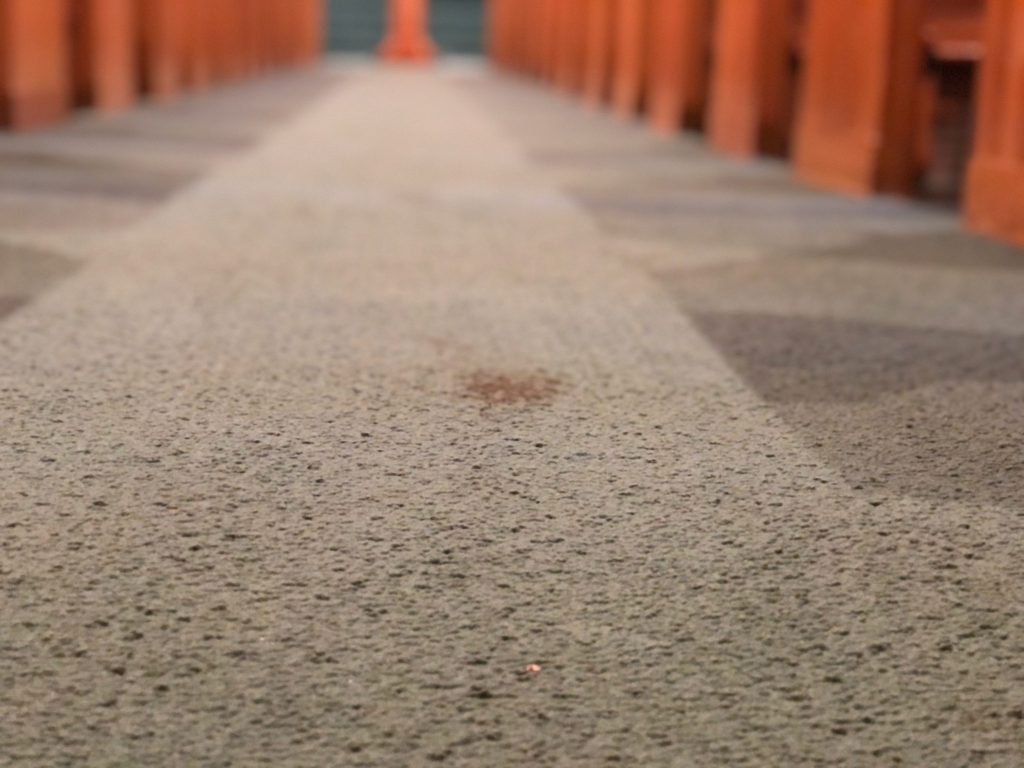I snapped this picture of a splotch of mud on our sanctuary carpet a few weeks ago. It was part of a trail of mud, all the way down the center aisle.
We had a lot of visitors that week; our first officially planned Sunday back inside our sanctuary since March 2020.
I had two immediate and unconscious thoughts when I saw it. First: “Oh, dang. Somebody tracked mud in the sanctuary.” And then: “Thank God! Somebody tracked mud into the sanctuary!!”
You know that in far too many churches, some version of the following might actually happen: Disturbed parishioners would call the pastor about the desecration of the holy space. A committee might be formed and meetings held. Ideas would be tossed around on how to prevent the future scourge of muddy feet. The church might buy the newest and best door mats. Church leaders would buy a plastic runner for the carpet, or disposable shoe coverings. (Kept in the narthex, next to the umbrella stand.) Ushers might “check feet” as folks came in the door. Printed signs might be tastefully placed on all exterior doors, and the verbiage added to the bulletin. The pastor would make an announcement before the start of the next week’s service, about how everyone needed to be on their best behavior and “check yourself.”
In sum, the energy, concern and precious time expended to combat the scourge of a splotch of mud could be staggering. (Please understand. I am not talking about your church, or mine, specifically. I’m asking you to pretend with me about what happens far too many places.)
I trust you know where I’m going. The pandemic year has reset everything. It’s peeled back layers of “the way we’ve always done things” and left them rotting in the gutter to be washed away by our copious spring rains.
Churches can no longer afford to waste their time on such nonsense. For decades, most churches have wrestled with their sense of calling or purpose, or how to attract and keep young folks, or how to become more diverse. All while the percentage of church-going Americans plummets, year-on-year.
Churches everywhere have an insidious way of “majoring in the minor.” We waste what poet Mary Oliver calls our “one wild and precious life,” solving problems that aren’t problems.
The world is complicated and real, gritty and challenging; filled with muddy ethical and social justice issues. And the “real world,” is always far, far “muddier” than the pretend world we too often play at inside a sanctuary’s walls. Right now, people are desperate for community, connection, and support, after a year of isolation.
After it dried, somebody broke out the vacuum and cleaned the splotch away. But for all of us who seek to welcome the community back, after a long year apart, keep meditating on this picture.
It’s a sign of hope. After a year of pandemic, I pray we all say: “Thank God! Somebody tracked mud into the sanctuary!!”
ERIC FOLKERTH is senior pastor of Kessler Park United Methodist Church. The Worship section is underwritten by Advocate Publishing and the neighborhood businesses and churches listed here. For information about helping support the Worship section, call 214.560.4202.





